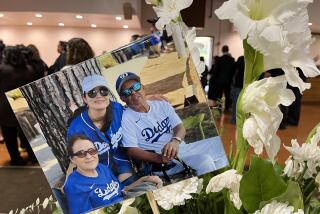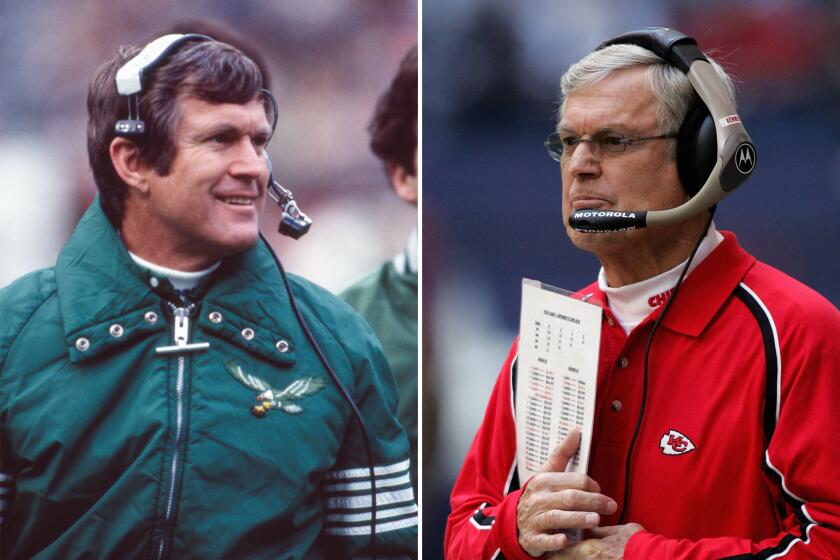The City of Angels Has Lost One of Its Heavenly Beings
- Share via
Jim Murray’s final column was from Del Mar, where “the turf meets the surf.” Bing Crosby used to sing that. Jim knew Bing Crosby.
Jim knew everybody back when Los Angeles, at least to those of us who grew up admiring it from afar, meant palm trees, movie studios, the Brown Derby and Schwab’s drugstore. He didn’t have to look up the facts about Joe DiMaggio and Marilyn Monroe in a book to write about them.
In one of the last conversations I had with Jim, I said Fred Couples had been rejected for membership at Los Angeles Country Club. Jim said celebrities had never been welcome there, recalling a story Victor Mature once told him about his application.
“They told him they didn’t admit actors,” Jim said. “He wrote them back saying he wasn’t one, and that he would send them copies of his last three films to prove it.”
Jim loved that L.A., loved talking and writing about it. That doesn’t mean he wasn’t current. He could write about Free House, the subject of his column Sunday after Del Mar’s Pacific Classic, as well as he could Citation, about Tiger Woods as well as he could Ben Hogan.
But Jim brought a perspective to his work that most of us trying to work the same beat can’t, providing a reminder that there was a Doris Day before there was a Demi Moore, an Elgin Baylor before a Magic Johnson, an Art Aragon before an Oscar De La Hoya, a Bob Waterfield before a John Elway.
When Jim died late Sunday night, so did part of Los Angeles.
And part of the Los Angeles Times.
If I had a dollar for every time someone told me he, or she, read our sports section because of Jim Murray, I’d join the L.A. Country Club.
I’ve never been insulted by that because, as far back as I can recall, Jim was the L.A. Times sports section. You didn’t have to grow up in Los Angeles to know that, any more than you had to be from here to know John Wooden was UCLA basketball or Vin Scully was Dodger baseball.
It isn’t much of an exaggeration to say that Jim was syndicated everywhere. I’ve read him in Athens, Texas. I’ve read him in Athens, Greece.
Some of us later discovered other writers who made us want to read the section. A few have gone on to achieve acclaim elsewhere, writers such as Rick Reilly and Richard Hoffer at Sports Illustrated, Skip Bayless at the Chicago Tribune, Scott Ostler at the San Francisco Chronicle, Mike Littwin at the Rocky Mountain News and Mike Downey in the A section here.
But no matter how talented they were, nobody who has walked through the door of our sports department since he first did in 1961 could ever hope to be anything more than Lou Gehrig to Jim’s Babe Ruth.
When Murray won the Pulitzer Prize for distinguished commentary in 1990, Downey, a much decorated sports columnist for us at the time, wrote, “If you think we’re just going to sit here and accept the fact that we are never going to be half the sportswriter you are, well, all I have to say is, mister, you’re right.”
The fact it took Murray so long to win a Pulitzer was a little embarrassing, for the Pulitzer.
Until he won one, the Pulitzer committee had seldom recognized sports columnists, never if they didn’t work for the New York Times. But Jim was too good to ignore forever, a columnist who wrote like no one else has before or since.
He had an inimitable style. When Times sportswriters covering a game would discuss their angles afterward so that there would be no duplication in the next morning’s paper, it wasn’t necessary to check with Jim. Even if you wrote the same subject, there was no way you could write the same column.
Not everyone liked everything he wrote. His famous line, “Gentlemen, start your coffins!” didn’t endear him to Indianapolis 500 officials.
I ran into him one year outside the press gate at Indy, waiting for his credential at the will-call window. I had already received mine, but I offered to wait with him in line.
“I wouldn’t if I were you,” he said. “They tend to lose mine every year.”
But I never knew anyone who didn’t like Jim.
He was as clever in person as he was in print. The first time I met him was in 1976 at the Montreal Olympics. The sports editor here at the time, Bill Shirley, had just assigned him to do an interview with Nadia Comaneci.
“A 14-year-old Romanian girl who doesn’t speak English,” Jim said, as exasperated as I ever heard him. “It’s like interviewing Rin Tin Tin.”
The thing I liked most about Jim, however, was his humility. After Jim won the Pulitzer, sports editor Bill Dwyre was quoted as saying we had agate clerks with bigger egos than Jim. It was true.
When he sent his 1993 autobiography to the publishers, they sent it back because he hadn’t written enough about himself. He thought the people he had covered, Arnold Palmer, Sandy Koufax, Bill Shoemaker, Jerry West, etc., were more interesting than he was. That wasn’t true.
I heard for the first time in 1984 that Jim might retire soon, after the Summer Olympics in Los Angeles. I have heard it many times since. In the back of my mind, I suppose I knew there would come a day when we would have to go on without him.
I just didn’t think it would be today.
More to Read
Go beyond the scoreboard
Get the latest on L.A.'s teams in the daily Sports Report newsletter.
You may occasionally receive promotional content from the Los Angeles Times.










